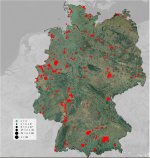That's the problem: It is used by dozens of institutions. If I and others just ignore it, many false and stupid things will happen.
Supposedly the new edition of Collins Bird Guide (Kosmos here) is supposedly already printed with new German names. I believe the book and the publisher will suffer from this.
The platform ornitho.de is formally required to follow the new decisions, too. But how do you implement changes that have no followership? If you want to report a Curlew will the entry mask change from "Großer Brachvogel" to "Brachvogel (Großer Brachvogel)"? How senseless is this?
Will fundings for reintroduction schemes for e.g. Ural Owl and Bald Ibis seize, once the species are classified as category C and thus as alien species? Not unlikely! We need a category A2 or something!!!
How are the relationships between different committees affected? Swiss and Austrian committees are already angry as they have had absolutely no say in the name changes. Nature conservation organisations are pissed, having to explain completely unnecessary changes to names such as Ziegenmelker. Members of their own committee didn't want to be mentioned as authors as they felt ignored and duped!
The whole process is so unnecessary, intransparent and inconsistent that there's major tension between ornithologist organisations.
And this is basically all just because of very few people who make these decisions, who think they know better than anybody else and who are too self-indulgent to cooperate and follow their own rules! To be clear: I don't think the different committees and organisations are bad. I just think some people who made it into these are destroying them and action needs to be taken to throw them out!







